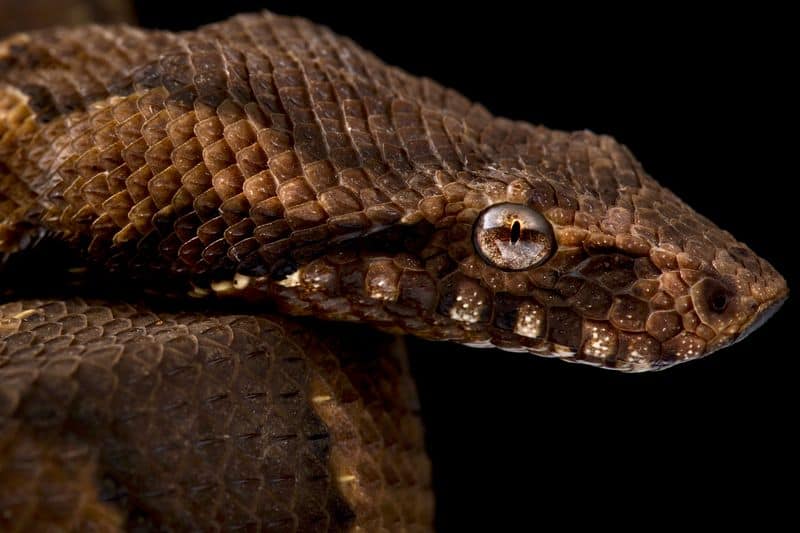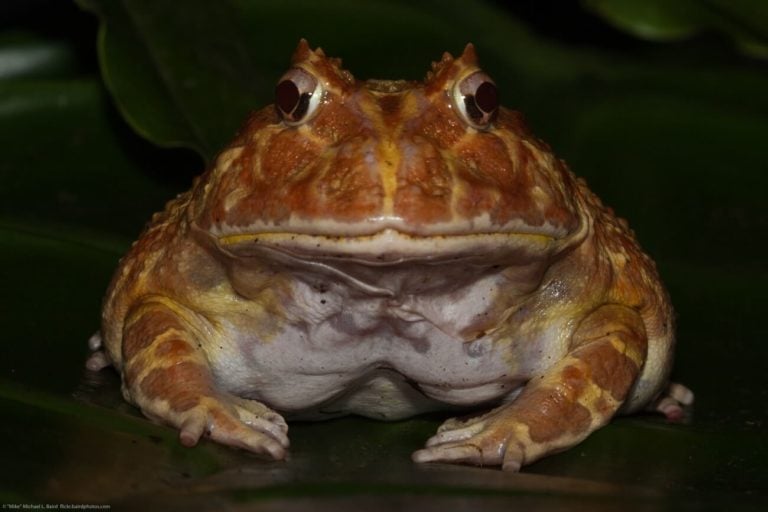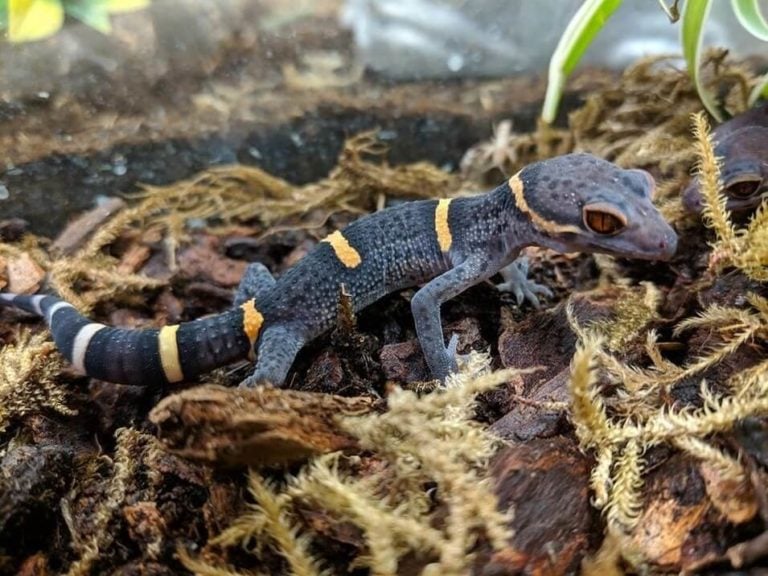Viper boas are interesting snakes that aren’t as common as other pet species. However, for the right kind of person they can be quite rewarding to own!
This guide goes over everything you need to know about viper boa care. We’ll cover their temperament, size, lifespan, habitat requirements, and more.
Table of Contents
Species Summary
The viper boa (Candoia aspera) is a small snake with an intimidating name. Despite its “viper” moniker, these serpents are not venomous. They simply get their name from their viper-like appearance.
In reality, viper boas have no relation to venomous vipers. They’re part of the Boidae family of snakes.
This species, also known as the New Guinea ground boa, is native to New Guinea. They’re also native to some parts of Indonesia. The snakes inhabit wet lowlands and forests where they spend most of their time hiding in leaf litter.
While not as common as other boas, the viper boa is a sought-after species in the pet trade. Known for somewhat challenging care requirements, most consider viper boas a better choice for those with some experience caring for snakes.
Appearance & Colors
This snake looks like other venomous species. Most notably, it looks strikingly similar to the Papua death adder. It shares the same triangular head, blunt nose, and keeled scales.
But don’t worry: viper boas lack the venom!
Viper boas are stocky snakes. They’re heavy-bodied and have short, nearly indistinguishable tails.

When it comes to color, viper boas can vary. Most have hues of black, gold, or red. The common color is brown, and most snakes have signature patterns of gray and black covering the body. They typically consist of spots or stripes, creating a recognizable saddle-like pattern that runs horizontally.
The coloration is an asset to this species. Their bodies blend well with their natural surroundings, allowing the snake to burrow in leaves and soil unnoticed.
Expert Tip: Viper boas are sexually dimorphic. Males have identifiable spurs on both sides of the vent that females lack. The spurs are even noticeable in juveniles, making it easy to differentiate the sexes.
Average Viper Boa Size
These snakes are stocky and muscular, but they’re not very long. The average size of an adult viper boa is two or three feet in length (24 to 36 inches).
Most snakes stay between this range. They can grow beyond three feet long, but those occurrences are rare. Because they’re on the shorter side, these snakes don’t require massive enclosures to stay happy.
Lifespan
On average, the lifespan of a viper boa is between 10 and 20 years. Wild-caught snakes live closer to 10 years, possibly living a few years longer, depending on their health and life before captivity. But if you get your snake from a breeder, you can expect around 20 years with your snake!
Of course, there are no guarantees for an animal’s lifespan. Many factors affect their longevity. The best thing you can do is provide the best care possible to help your snake live a long and healthy life.
Viper Boa Care
Proper viper boa care isn’t always easy. This snake has distinct requirements that not everyone can meet. As a result, seasoned snake-keepers often say this species is best for people with experience.
Here’s what you need to know about caring for a viper boa.
Enclosure Size
Let’s start with one of the most important aspects of viper boa care. The enclosure must be large enough to accommodate your snake’s size while giving it ample room to live a fulfilling life.
At a minimum, viper boas need a habitat that measures 36 inches long, 24 inches wide, and roughly 18 inches tall. That’s the smallest you should go for a mature viper boa. If it’s possible, go bigger!
Unlike other snake species, viper boas aren’t big climbers. As a result, floor space should be a priority. Go for longer and wider vivariums over tanks that offer height. Some snake-keepers house these serpents in tubs.
Tubs and secure containers with opaque sides work well. Viper boas tend to be on the shyer sides, and some snakes don’t like the openness of glass tanks. This can vary from snake to snake, so you may need to see what your boa prefers.
What to Put in Their Habitat
While these snakes can do fine in bare-bone enclosures, the best approach is to create a habitat that mimics their natural environment.
Start with a layer of soft and pliable substrate. Avoid hard materials like gravel or non-moving substrates like reptile carpets. Viper boas like to burrow, so materials like cypress mulch, coconut husk, and snake-friendly soil work best. Those substrates also do a fine job of retaining moisture. More on that later.
Create a layer of substrate that’s at least three inches deep. If you have a particularly tall enclosure, you can create even more depth to encourage the snake’s burrowing behavior.
There’s no need to add branches or climbing accessories. Viper boas stick to the ground, so focus your attention on creating a rich environment with plants and hide boxes.
You can use silk plants that won’t scratch your snake as they slither around. Many snake enthusiasts also keep live plants. Good plant species include ficus, spider plants, and ferns.
Add at least two hide boxes in the enclosure. You can use slate, wood, cork bark or even plastic containers. The hides should be big enough to accommodate the viper boa’s body as they slither inside. Place hides on opposite ends of the enclosure.
Temperature & Lighting
Like other snakes, viper boas are cold-blooded animals that move throughout their environment to thermoregulate. Therefore, you must create a temperature gradient. One side needs to be cooler than the other. That’s why you put the hide boxes on opposite ends of the enclosure!
The cool side of the tank should be around 78 degrees Fahrenheit. If you live in an area that gets colder than that throughout the night, install heat emitters or under-tank heating mats to stabilize temperatures. On the hot end, aim for around 85 degrees.
Viper boas are nocturnal. As a result, they don’t need a hotter basking area like some pet snakes. You also don’t have to worry about UVB lighting! A simple lighting rig on a timer will do.
A low-wattage bulb is all you need. Viper boas need at least 12 hours of light to maintain their circadian rhythm.
Humidity
Maintaining high humidity levels is one of the most challenging aspects of caring for a viper boa. This species needs a relative humidity between 70 and 80 percent.
Invest in a digital hygrometer to keep tabs on humidity levels throughout the day. Regular misting is a must. Many owners install automatic misters to keep humidity stable.
An absorbent substrate and live plants will make a big difference in keeping the enclosure humid.
Water
The final thing you must install inside your viper boa’s habitat is a water bowl. The bowl should be large enough for the snake to soak in and be topple-proof.
Viper boas don’t lap up water, but they will soak regularly. Keep an eye on the water’s condition. Many snakes will defecate in the water bowl, so you must clean and replenish it regularly.
Food & Diet
Viper boas are carnivores. In the wild, they typically feed on small reptiles, amphibians, and rodents.
In captivity, the go-to food item for viper boas is feeder mice. While some snake-keepers are adamant about providing live mice, most experts agree that pre-killed mice are the better choice. Live rodents could scratch your snake, increasing the chances of health problems.
The rodents themselves could also carry diseases that pass onto your snake. That’s why we recommend pre-killed frozen feeder mice. Thaw the mice to room temperature and use soft-tipped tongs to lower the food into the enclosure.
Expert Tip: The size of the rodent should be smaller than the widest part of your snake’s body. Anything bigger presents a choking hazard.
Adult viper boas should eat once every two or three weeks. Their metabolisms are much slower, so they don’t require frequent feedings. Meanwhile, juveniles are more active and use more energy. Therefore, they should eat once a week.
Remember to feed your viper boa at night. These nocturnal snakes hunt when it’s dark, so attempting to feed them during the day will be fruitless.
Potential Health Issues
Viper boas don’t have any special health concerns to worry about, but they are susceptible to many common ailments. Like any other snake, viper boas can experience mouth rot, respiratory infections, mites, and parasites.
Mouth rot is a common infection that results in inflammation of the soft tissue lining the mouth. In most cases, poor environmental conditions are to blame. Monitor the temperature and humidity levels closely to avoid problems.
Respiratory infections are similar to mouth rot. However, these infections can also cause mucus buildup, discharge, and lethargy. Both mouth rot and respiratory infections are relatively easy to treat with antibiotics, but you should pay attention to the enclosure’s conditions to avoid these problems.
Skin mites and infections are possible, too. These problems are a result of poor husbandry. Bacteria can cause major issues if you fail to clean your snake’s enclosure regularly.
Spot clean messes and clean the water bowl whenever it gets dirty. About once a month, do a full enclosure sanitization. Replace the substrate and wipe down all surfaces with a reptile-safe disinfectant. Avoid using anything with harsh chemicals like bleach.
Stay on top of enclosure maintenance. Poor tank maintenance is one of the leading causes of health problems in viper boas and other snakes. Monitoring conditions and cleaning regularly can make a big difference.
Behavior & Temperament
Viper boas have a reputation for being aggressive. These snakes can indeed lash out and bite you. However, there are ways to avoid those behaviors.
You’re more likely to see aggression in wild-caught viper boas. These snakes aren’t used to human interaction, so they tend to go into defense mode immediately. While viper boas aren’t venomous, bites can hurt!
These snakes have sharp teeth that can do considerable damage!
The best thing you can do to avoid aggression is to purchase captive-bred snakes. Viper boas can be quite docile, but they need a long history of socialization to get there. Snakes need human exposure from a young age to get comfortable with your presence.
Don’t be surprised if your juvenile viper boa gets bitey. That’s common with this species. The goal is not to push your snake.
You want to be present and build trust. That requires regular interactions. Over time, viper boas will get used to you.
Once they get to that point, they are pretty relaxed and docile.
Handling Them
Viper boas will tolerate handling once they trust you. However, there’s still a risk of a bite.
These snakes tend to lash out when you first stick your hand in the enclosure. The habitat you create is their safe space. A well-designed home will allow the snake to relax and put their guard down.
So when you stick your hand into their domain, they get defensive.
One way to avoid getting bit is to use a snake hook. Most viper boas will use the hook to lift the snake out of the habitat because it’s less intimidating than a hand. Most snakes will not get stressed when you use a snake hook, so it’s a good way to keep things mellow.
When handling a viper boa, support the entire body. These snakes are stocky and heavy. Failing to hold them correctly could result in stress and injury to the snake.
Limit your handling sessions to no longer than 15 minutes. Viper boas tolerate being handled, but they don’t necessarily enjoy it.
In that 15 minutes, allow your snake to get comfortable. It may wrap around your arm or slither on your body before settling. Allow it to get cozy and constantly support its weight to avoid stress.
It’s also a good idea to avoid sudden movement or loud noises. Never handle these snakes around other pets or rowdy children. These snakes are sensitive, especially during the day.
Sudden stimuli will create unnecessary stress and can lead to a painful bite.
Closing Thoughts
As you can see, viper boa care does come with some considerations. If you’re a beginner or someone who wants a hands-off snake to own, this might not be the species for you.
But if you’re someone who enjoys a challenge and is drawn to pet snakes that are a bit less common, the viper boa is worth considering!


